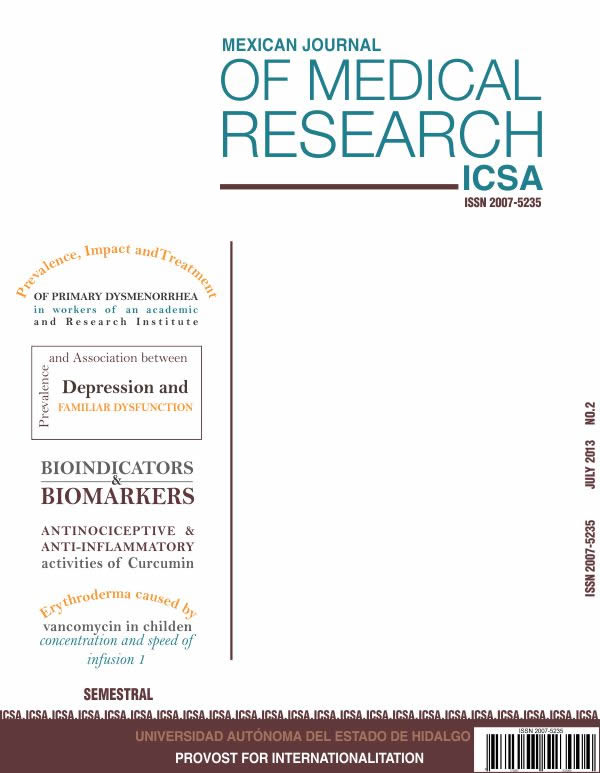Prevalence and Association between Depression and Familiar Dysfunction
DOI:
https://doi.org/10.29057/mjmr.v1i2.1784Keywords:
Prevalence, Depression and Family DysfunctionAbstract
Family dysfunction originates psychosocial problems and a high demand of health services. Depression, a multi-factor disease, has individual and social aspects that depend each other, forming a vicious circle. It may be possible to find an association between family dysfunction and depression. The aim of this study was to determine the prevalence and the degree of association between depression and family dysfunction, in patients attending to the outpatients’ clinic of Family Medicine at Pachuca, Hidalgo. A cross-sectional and comparative study was completed, from October 2007 to January 2008, with patients attending the outpatients’ clinic of Family Medicine in Pachuca, Hidalgo, whom agreed to answer the tests: Zung, FASES, Family APGAR and Holmes. The statistical parameters, prevalence and Odds Ratio were obtained. X2 test was applied with a confidence interval of 95%, a p<0.05 value was considered significant. One hundred fifty-five women and 100 men were included, with a mean age 34.4 ± 12.9 years. Zung test for depression showed a prevalence of 34.9%, wherein 83.1% corresponded to slight depression, 14.7% to moderate depression and 2.2% to severe depression. FASES showed 53.3% of families in the medium range. Whereas Family APGAR demonstrated a 54.1% of functional families and the test of Holmes reported 47.1% without problems and 24.7% with moderate crisis. There were no significant differences in age, occupation and gender, neither association between depression and familiar dysfunction. It is concluded that 34.9% showed some degree of depression, which varied from dysthymia to severe depression. It is suggested to carry out screening programs and to provide an early treatment.
Downloads
Publication Facts
Reviewer profiles N/A
Author statements
- Academic society
- N/A
- Publisher
- Universidad Autónoma del Estado de Hidalgo
References
2 Amescua-Aguirre R, Arce-Gutiérrez E, Arteaga-Aceves G, Bonilla-Marín FR, Buendía-Palao J, Castro-Cante J, et al. Fundamentos de medicina familiar, 7a ED. Distrito Federal. México. Editorial Medicina Familiar Mexicana; 2000: 25-31.
3 Meneses-Garduño J. Suicidio en los adolescentes. En: Programa de Actualización Continua en Medicina Familiar. Libro 1 (PAC MF-1). Distrito Federal México. Intersistemas Editores; 1999: 40-68.
4 Rubinstein A. Medicina familiar y práctica ambulatoria. Distrito Federal México: Editorial Médica Panamericana; 2001: 181-93.
5 Caraveo-Anduaga JJ, Martínez-Vélez NA, Rivera-Guevara BE, Polo-Dayan A. Prevalencia en la vida de episodios depresivos y utilización de servicios especializados. Salud mental 1997; 20: 15-23.
6 Berlanga C. El trastorno depresivo evaluado bajo una perspectiva fenomenológica. Salud mental 1999; 22: 26-32.
7 Lara MA, Navarro C, Navarrete L, Mondragón L, Rubí NA. Seguimiento a dos años de una intervención psicoeducativa para mujeres con síntomas de depresión, en servicios de salud para población abierta. Salud mental 2003; 26: 27-36.
8 Camacho-Beltrán JM, Macedo-Ortiz E, Veras-Godoy H, Gil-Borja E, Granados-Díaz A. Salud mental. Boletín de la UAEH, Escuela de Medicina 2003; 1: 1-15.
9 Singer K, Armitaje KB, Buynak RJ, Cheng KS, Chicoyen LS, Colodny C, et al. Cambio de actitudes hacia la depresión. National mental Health Association. Atención Médica 2002; 15: 9-10.
10 Vélez, et al. Fundamentos de medicina familiar. Medellín Colombia. Editorial Corporación para investigaciones biológicas; 1998: 131-5.
11 Carnes RM, Freedland KE. Depresión en pacientes con enfermedad de las arterias coronarias. Mundo Médico 1999; 26: 84-9.
12 Guck TP, Kavan MG, Elsasser GN, Pharm D, Barone EJ. Assessment and Treatment of depression following myocardial infarction. Am. Fam. Physician 2001; 64: 641-8.
13 Nesse RE, Finlayson RE. Management of depression in patients with coexisting medical illness. Am. Fam. Physician 1996; 1: 2125-33.
14 Allen F, Pincus HA, Firts MB, Coover AN, Barlow DH, Campbell M, et al. DSM-IV Manual diagnóstico y estadístico de los trastornos mentales. Barcelona, España: Masson S.A.; 1999: 181-24.
15 CIE-10. Organización Panamericana de la Salud, OMS. Décima revisión. Ginebra. 1996.
16 Martell-Gamez VA. Boletín del “Curso fascicular de depresión”. Sistema de educación medica continua para el medico general y familiar. Distrito Federal México: 2003: 1-12.
17 Howard H. Psiquiatría general. 3a ED. Distrito Federal México: Manual moderno; 1994: 300-9.
18 Lara MA, Navarro C, Mondragón L, Rubí NA, Lara MC. Validez y confiabilidad del MHI-5 para evaluar la depresión de mujeres en el primer nivel de atención. Salud mental. 2002; 25: 13-20.
19 Bello M, Puentes-Rosas E, Medina-Mora ME, Lozano R. Prevalence and diagnosis of depression in México. Salud Púb. Méx. 2005; 47 Suppl 1: S4-11.
20 Reyes-Ortega M. Soto-Hernández AL, Milla-Kegel JG, García-Ramírez A, Hubard-Vignau L, Mendoza-Sánchez H, et al. Actualización de la escala de depresión del centro de estudios epidemiológicos (CES-D) estudio piloto en una muestra geriátrica mexicana. Salud Mental. 2003; 26: 59-68.
21 Maier W, Philip M, Heuser I, Schlegel S, Buller R, Wetzel H. Improving depression severity assessment I and II. Reliability, internal validity and sensitivity to change of three observer depression scales. J. psychiat. 1988; 22: 3-19.
22 www.medicinainformacion.com/psq_ test_tanimo2.htm
23 Palomar J. Relación entre el funcionamiento familiar y la calidad de vida en familias con un miembro alcohólico. Salud mental. 1999; 22: 13-21.
24 Tuesca-Molina R, Fierro-Herrera N, Molinares-Sosa A, Oviedo-Martínez F, Polo-Arjona Y, Polo-Cueto J, et al. Los grupos de socialización como factor protector contra la depresión en personas ancianas. Baranquilla, Colombia. Rev. Esp. Salud Púb. 2003; 77: 595-604.
25 Lara MA, Mondragón L, Rubí NA. Un estudio de factibilidad sobre la prevención de la depresión en las mujeres. Salud mental. 1999; 22: 41-7.
26 Ko DT, Hebert PR, Coffey CS, Sedrakyan A, Curtis JP, Krumholz HM. B –Blocker therapy and symptoms of depression, fatigue, and sexual dysfunction. JAMA 2002; 288: 351-7.
27 De la Peña F, Ulloa RE, Páez F. Comorbilidad del trastorno depresivo mayor en los adolescentes. Prevalencia, severidad del padecimiento y funcionamiento psicosocial. Salud mental 1999: 88-91.
28 Zapata-Gallardo JN, Figueroa-Gutiérrez M, Méndez-Delgado N, Miranda-Lozano VM, Linares-Segovia B, Carrada-Bravo T, et al. Depresión asociada a la disfunción familiar en la adolescencia. Bol. Med. Hosp. Infant. Mex. 2007; 64: 295-301.
29 Leyva-Jiménez R, Hernández-Juárez AM, Nava-Jiménez G, López-Gaona V. Depresión en adolescentes y funcionamiento familiar. Rev. Med. Inst. Mex. Seg. Soc. 2007; 45: 225-32.






















